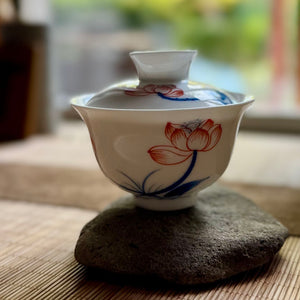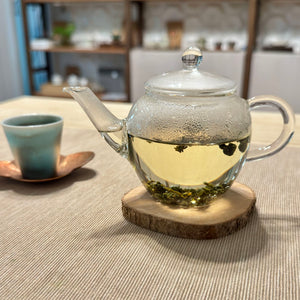Making tea in a gaiwan
Making tea in a gaiwan
A gaiwan (蓋碗) is a lidded cup without handles used for brewing loose tea. It is one of the most versatile tea making tools and has been the most popular tea making tool in China since the Ming Dynasty.
Most gaiwans are made of porcelain, which is particularly suitable for green, lighter oolong and white teas - they are recommended to be brewed at a lower temperature.
One of the great advantages of the gaiwan is that during infusions we can easily observe the development of the tea leaves as they slowly open and regain their original shape and size. This tool can be used not only for making tea, but also for drinking directly, as is done in the famous tea houses of Chengdu to this day: we can strain the leaves with the lid or even with our front teeth.
In this guide, we will be making Baozhong oolong tea, which has a twisted leaf shape. This type of tea (such as Baozhong or Jade Rouge) steeps faster than rounded leaf varieties (such as Frozen Summit), so you may want to keep the steeping time to around 1 minute instead of the usual 2 minutes.
In addition to the recommended ratio (4 grams of tea, 100 ml of water), we recommend 3 infusions with the same tea leaves – but of course it is worth adjusting the proportions to your own taste. If possible, use all three infusions the same day. The recommended steeping time may vary depending on the tea, feel free to experiment – experience what tastes best!
Making tea in a gaiwan - Step by step
Step 1: Measure the tea leaves
Measure out 4 grams of oolong tea. Using a scale will help you use an accurate amount, regardless of the size or shape of the leaves.
Step 2: Rinse and preheat the gaiwan
Use hot water (between 90 and 100°C, or 195, 200, or 212°F) to rinse the gaiwan. This is the same temperature you will use to brew your tea. Preheating the device will help the tea steep more evenly. Always follow the instructions on the tea’s page for the exact temperature.
Step 3: Add the tea to the gaiwan
Pour the water out of the gaiwan and add the measured, loose tea leaves. The warm cup helps the leaves' aroma and flavor develop more quickly.
Step 4: Pour the water on it
Pouring the water around the edge turns the tea leaves so they are evenly moistened.
In general, lower water temperatures (~90–95°C) are recommended for twisted leaf teas, while higher water temperatures (~100°C) are recommended for tightly rolled leaves. The different temperatures help to release the best flavors from the leaves.
Pre-rinsing the tea is optional, not mandatory.
Step 5: Move the letters
Use the lid of the gaiwan to stir the leaves a little – this will ensure even soaking.
Step 6: Let the tea steep
Steep the tea for 1 minute. For tightly rolled leaves, this may take up to 2 minutes. During this time, you can also preheat the pourer and cups.
Step 7: Prepare for the spill
Gently tilt the gaiwan lid so that there is only a narrow gap between the rim and the lid, then hold the lid down with your finger. Then, grasp the two sides of the gaiwan – one side with your thumb, the other side with your middle and ring fingers.
Step 8: Pour the tea into a pitcher
Once the steeping time is up, pour the tea into a decanter or mug. It is important to remove all the liquid from the gaiwan – this will prevent the tea from getting too hot and bitter before the next pour. If you want to avoid small pieces of tea in your drink, you can use a fine strainer.
Step 9: Pour into cups
Pour the tea into the cups and enjoy the moment!
Step 10: Re-pouring – multiple pours
You can re-infuse the tea as desired. At this dosage (4 g tea, 100 ml water), we recommend three infusions. For the second infusion, use a similar steeping time as the first, and for the third, it is worth extending the steeping time by 1–2 minutes. Each additional infusion will highlight different flavor notes, allowing you to explore the complexity of the tea more deeply.

Making tea in a Gaiwan
Brewing tea in a gaiwan is one of the most elegant and ancient forms of Chinese tea culture. This method allows us to discover new layers of flavor in the tea with each pour.
Making tea in a clay teapot
Brewing tea in a clay teapot adds a special depth and roundness to the drink, especially for oolong, puer or black teas. This traditional method enriches not only the tea, but also the tea-drinking experience.
Making cold brew tea
Cold brew tea is a refreshing, smooth and naturally sweet alternative to hot water brews. It's easy to make and ideal for summer days or on the go.

Making tea using a French press
A French press is a great tool not only for coffee but also for tea – fast, convenient and surprisingly efficient. It is the ideal choice for those who simply want to get the most out of their loose teas.


